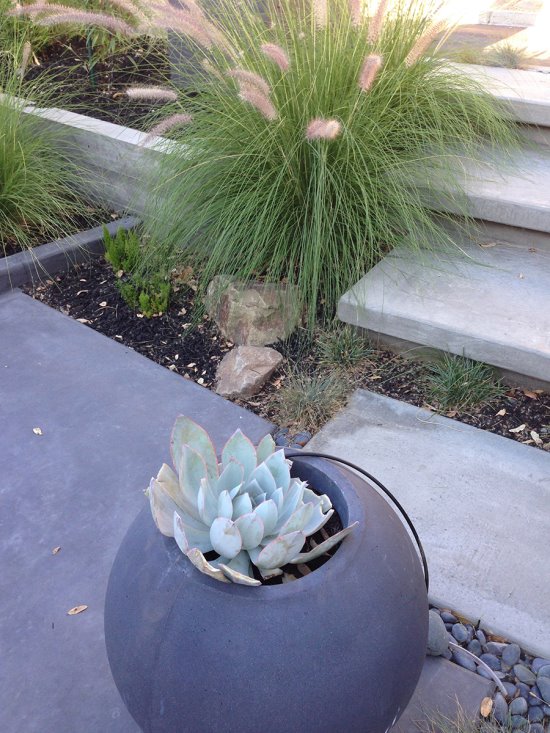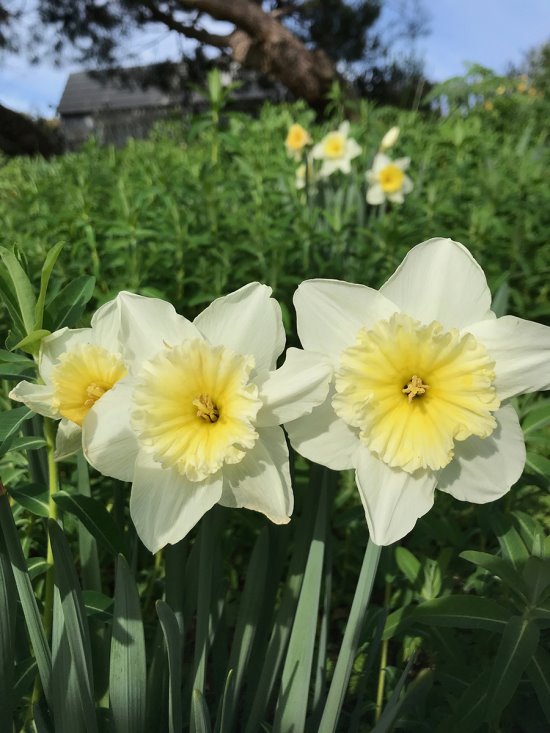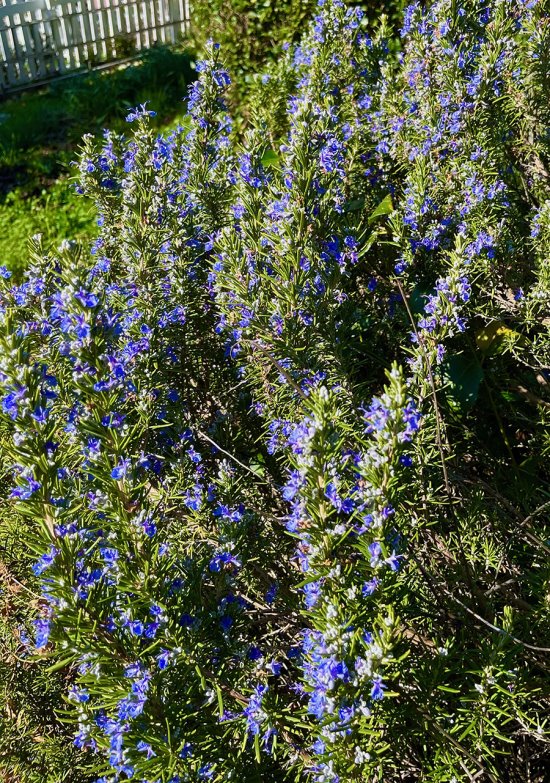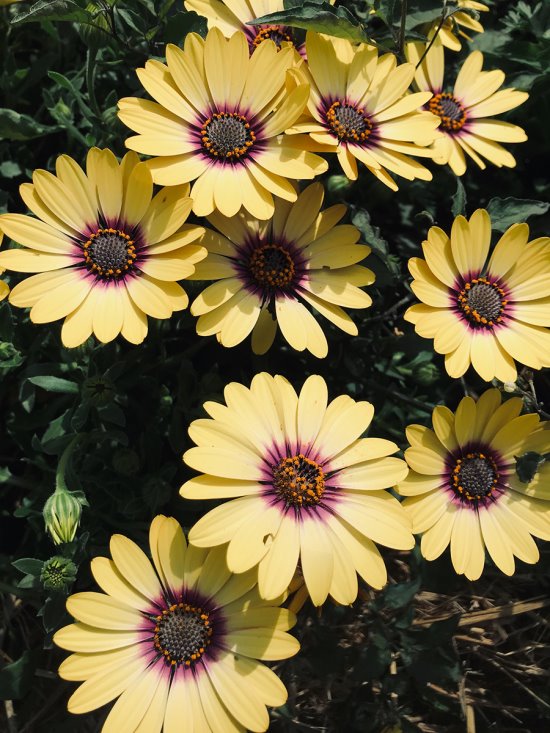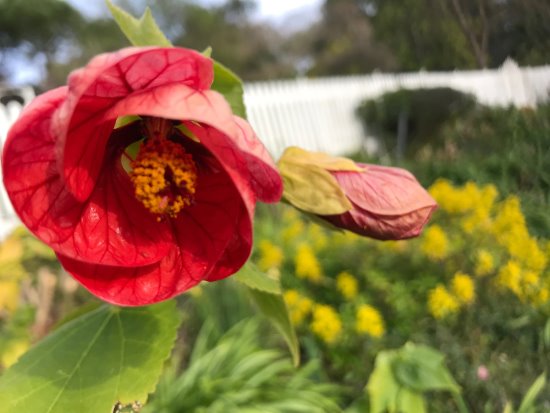 |
|
|
Red Chinese lantern is a perennial. Photo Cynthia Brian
|
|
|
|
|
|
"That which surrounds you is within you." ~?Karl Schmidt

 Days of heat followed by days of near-freezing cold! Out of nowhere, a beautiful hailstorm covers the ground in white pebbles. The weather forecasts sunshine or cloud cover, but no rain in future days. According to the New York Times, the seven hottest years on record globally were experienced in the last seven years. The atmospheric river of December provided a respite and a hopeful prospect for drought relief. January, February and March are traditionally the wettest months here in California, but this year, January and February were the driest in years and March isn't looking much better. Maybe the Irish leprechauns will exert their magical powers to make it rain on St. Patrick's Day!
Days of heat followed by days of near-freezing cold! Out of nowhere, a beautiful hailstorm covers the ground in white pebbles. The weather forecasts sunshine or cloud cover, but no rain in future days. According to the New York Times, the seven hottest years on record globally were experienced in the last seven years. The atmospheric river of December provided a respite and a hopeful prospect for drought relief. January, February and March are traditionally the wettest months here in California, but this year, January and February were the driest in years and March isn't looking much better. Maybe the Irish leprechauns will exert their magical powers to make it rain on St. Patrick's Day!
 Designing for drought:
Designing for drought:
 As I gaze upon my peach tree blossoms intermingled with crabapple buds blooming much too early, I admit that I am basking in this early spring. Although I am an eternal optimist who imagines positive outcomes, if we want our gardens to survive and thrive, we need to design for the drought. Here's how to get started now to be ready for whatever transpires as the months warm.
As I gaze upon my peach tree blossoms intermingled with crabapple buds blooming much too early, I admit that I am basking in this early spring. Although I am an eternal optimist who imagines positive outcomes, if we want our gardens to survive and thrive, we need to design for the drought. Here's how to get started now to be ready for whatever transpires as the months warm.
 1) Check for leaks. Make sure that your outside pipes are insulated against freezing. Water expands when it freezes causing pipes to burst. Even a tiny 1/8-inch crack could spew 250 gallons of water per day. If you witness wet spots, water running along driveways, or puddles, investigate for a leak. Check hose bibs for drips, replace washers, and routinely inspect automatic sprinklers and connections.
1) Check for leaks. Make sure that your outside pipes are insulated against freezing. Water expands when it freezes causing pipes to burst. Even a tiny 1/8-inch crack could spew 250 gallons of water per day. If you witness wet spots, water running along driveways, or puddles, investigate for a leak. Check hose bibs for drips, replace washers, and routinely inspect automatic sprinklers and connections.
 2) Amend the soil. The foundation of every garden is the soil. The ideal soil drains quickly while storing water. For drought toleration, add several inches of rich, organic compost to encourage deep root formation while trapping moisture. Make your compost by adding kitchen scraps, eggshells, coffee grinds, tea leaves, shredded newspaper, leaves, lawn clippings, fish bones, aged manure, non-diseased weeds, and other organic matter to a bin or pile.
2) Amend the soil. The foundation of every garden is the soil. The ideal soil drains quickly while storing water. For drought toleration, add several inches of rich, organic compost to encourage deep root formation while trapping moisture. Make your compost by adding kitchen scraps, eggshells, coffee grinds, tea leaves, shredded newspaper, leaves, lawn clippings, fish bones, aged manure, non-diseased weeds, and other organic matter to a bin or pile.
 Do not use human, dog, or cat feces. Don't disturb the lower levels of the ground to allow worms and micro-bacteria to do their jobs of aerating and feeding the earth. In a drought, double and triple digging techniques are not recommended.
Do not use human, dog, or cat feces. Don't disturb the lower levels of the ground to allow worms and micro-bacteria to do their jobs of aerating and feeding the earth. In a drought, double and triple digging techniques are not recommended.
 3) Water well. To stay healthy, most plants need at least one inch of moisture per week. The best way to save your plants as well as conserve water is to water deeply and infrequently.
3) Water well. To stay healthy, most plants need at least one inch of moisture per week. The best way to save your plants as well as conserve water is to water deeply and infrequently.
 The penetration of the water encourages deeper roots that are more resistant to drought conditions. A good rule of thumb is to water until the dirt has a hint of shine. Lawns and bedding plants require a drink to a depth of six inches while perennials, trees, and shrubs need closer to 12. Plan to irrigate either early in the morning or evening when absorption will be maximized, and evaporation minimized. Just as humans rejuvenate from a good night's rest, plants do most of their growing at night. Traditional overhead sprinklers can lose half of their effectiveness to evaporation, run-off, and overspray. Drip and soaker hoses are the best bets for deep soaking to the root zone. Soaker hoses may be covered with mulch making them invisible. When water is restricted prioritize rationing by watering, in this order, newly planted trees, shrubs, and perennials; newly seeded or repaired lawns; plants with exposure on windy sites or in sandy soils; and flowering vegetables.
The penetration of the water encourages deeper roots that are more resistant to drought conditions. A good rule of thumb is to water until the dirt has a hint of shine. Lawns and bedding plants require a drink to a depth of six inches while perennials, trees, and shrubs need closer to 12. Plan to irrigate either early in the morning or evening when absorption will be maximized, and evaporation minimized. Just as humans rejuvenate from a good night's rest, plants do most of their growing at night. Traditional overhead sprinklers can lose half of their effectiveness to evaporation, run-off, and overspray. Drip and soaker hoses are the best bets for deep soaking to the root zone. Soaker hoses may be covered with mulch making them invisible. When water is restricted prioritize rationing by watering, in this order, newly planted trees, shrubs, and perennials; newly seeded or repaired lawns; plants with exposure on windy sites or in sandy soils; and flowering vegetables.
 4) Mulch. Three inches of mulch will insulate your plants from the heat, cold, and elements. Mulch keeps the ground cooler, maximizes water retention, reduces evaporation, and improves the appearance of your landscape. Mulch includes pine needles, straw, leaves, wood chips, bark, and even gravel. As it decomposes it becomes compost and enriches the soil. When that happens, it is time for a new top layer of the mulch of your choice.
4) Mulch. Three inches of mulch will insulate your plants from the heat, cold, and elements. Mulch keeps the ground cooler, maximizes water retention, reduces evaporation, and improves the appearance of your landscape. Mulch includes pine needles, straw, leaves, wood chips, bark, and even gravel. As it decomposes it becomes compost and enriches the soil. When that happens, it is time for a new top layer of the mulch of your choice.
 5) Weed. Weeds steal moisture and nutrition from neighboring plants. Pull or cut down unwanted weeds.
5) Weed. Weeds steal moisture and nutrition from neighboring plants. Pull or cut down unwanted weeds.
 6) Stop fertilizing. If you plan to fertilize this season, do it now while the weather is still cool, and dew is apparent. Feeding while it is raining is the best prescription for plant wellness. If you fertilize without sufficient water, the roots will burn, and the plants will die. Fertilizing encourages new growth and new growth will stress your already stressed specimens. As the weather warms, refrain from fertilizing again until rain is forthcoming.
6) Stop fertilizing. If you plan to fertilize this season, do it now while the weather is still cool, and dew is apparent. Feeding while it is raining is the best prescription for plant wellness. If you fertilize without sufficient water, the roots will burn, and the plants will die. Fertilizing encourages new growth and new growth will stress your already stressed specimens. As the weather warms, refrain from fertilizing again until rain is forthcoming.
 7) Plant for drought. I'm a big believer in bulbs. In our temperate climate, you dig a hole, plant, forget, then be awed when bulbs pop up and bloom. Daffodils, calla lilies, freesia, hyacinths, Dutch iris, and many others are all excellent spring-blooming bulbs that require minimal care and reap huge bloom benefits. For summer flowering, plant gladiolus, Naked ladies, agapanthus, Asian lilies, tuberous begonias, dahlias, iris, and canna. Succulents offer a magnificent maintenance-free drought investment. Succulents come in many shapes, sizes, and colors with beautiful blooms and little water requirements. Sedums are spectacular as groundcovers or upright attracting bees and butterflies. Jade, echeveria, senecio, haworthias, aconium, and ice plant all have varied textures and attractive flowers. Unlike cactus, succulents don't have thorns, making them a favorite for rock gardens.
7) Plant for drought. I'm a big believer in bulbs. In our temperate climate, you dig a hole, plant, forget, then be awed when bulbs pop up and bloom. Daffodils, calla lilies, freesia, hyacinths, Dutch iris, and many others are all excellent spring-blooming bulbs that require minimal care and reap huge bloom benefits. For summer flowering, plant gladiolus, Naked ladies, agapanthus, Asian lilies, tuberous begonias, dahlias, iris, and canna. Succulents offer a magnificent maintenance-free drought investment. Succulents come in many shapes, sizes, and colors with beautiful blooms and little water requirements. Sedums are spectacular as groundcovers or upright attracting bees and butterflies. Jade, echeveria, senecio, haworthias, aconium, and ice plant all have varied textures and attractive flowers. Unlike cactus, succulents don't have thorns, making them a favorite for rock gardens.
 Don't forget to plant edibles. A small 4-foot by 8-foot bed can be planted with plenty of nutritious vegetables and herbs to feed a family of four. Decide what you enjoy eating and plant only those to avoid watering vegetables that you won't consume.
Don't forget to plant edibles. A small 4-foot by 8-foot bed can be planted with plenty of nutritious vegetables and herbs to feed a family of four. Decide what you enjoy eating and plant only those to avoid watering vegetables that you won't consume.
 Surrounding me now is plenty of sunshine and within I feel sunny and bright. Yet, I'm counting on the luck of the Irish to bring a bit of Emerald Isle precipitation to the shores of California this St. Paddy's Day! In case there isn't that pot of gold at the end of the rainbow, I'm designing for drought.
Surrounding me now is plenty of sunshine and within I feel sunny and bright. Yet, I'm counting on the luck of the Irish to bring a bit of Emerald Isle precipitation to the shores of California this St. Paddy's Day! In case there isn't that pot of gold at the end of the rainbow, I'm designing for drought.
 Goddess Gardener Cynthia Brian's Gardening Guide for March
Goddess Gardener Cynthia Brian's Gardening Guide for March
 FERTILIZE hungry lawns to strengthen roots, resist cold, heat, and high traffic when weather is wet. This feeding will help combat the stress of drought.
FERTILIZE hungry lawns to strengthen roots, resist cold, heat, and high traffic when weather is wet. This feeding will help combat the stress of drought.
 AERATE your lawn. The soil is compacted from winter rains and foot traffic. Leave the plugs to add nutrients back into the grass.
AERATE your lawn. The soil is compacted from winter rains and foot traffic. Leave the plugs to add nutrients back into the grass.
 CONTINUE to protect frost tender plants
CONTINUE to protect frost tender plants
 POUR chamomile tea around the base of newly planted seedlings to eliminate fungus growth.
POUR chamomile tea around the base of newly planted seedlings to eliminate fungus growth.
 CUT boughs of camellias to use in a bowl or arrangement.
CUT boughs of camellias to use in a bowl or arrangement.
 PAMPER yourself with an exfoliating and moisturizing facial from your garden. Squeeze lemon juice from your Meyer lemon tree into a bowl and mix with lavender petals and 1/4 cup olive oil. Home brewed spa experience in 20 minutes.
PAMPER yourself with an exfoliating and moisturizing facial from your garden. Squeeze lemon juice from your Meyer lemon tree into a bowl and mix with lavender petals and 1/4 cup olive oil. Home brewed spa experience in 20 minutes.
 CONTINUE to compost, compost, and compost. This is the single most important ingredient of growing a great garden. Buy an inexpensive compost bin from your local waste service.
CONTINUE to compost, compost, and compost. This is the single most important ingredient of growing a great garden. Buy an inexpensive compost bin from your local waste service.
 SPADE six inches of rich compost into your vegetable garden in preparation for the next season's plantings.
SPADE six inches of rich compost into your vegetable garden in preparation for the next season's plantings.
 SCATTER a canister of California poppy seeds for a carefree, drought-tolerant golden showstopper.
SCATTER a canister of California poppy seeds for a carefree, drought-tolerant golden showstopper.
 Happy Gardening. Happy Growing. Happy St. Patrick's Day!
Happy Gardening. Happy Growing. Happy St. Patrick's Day!
|




